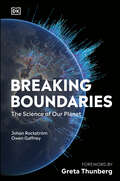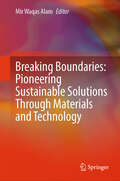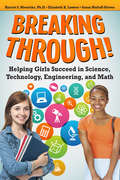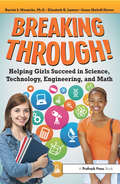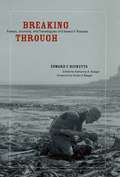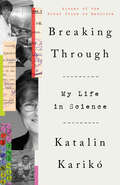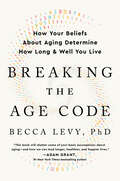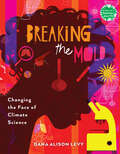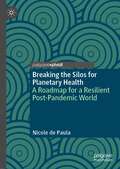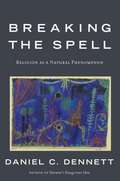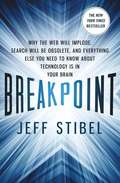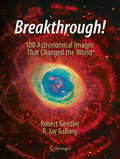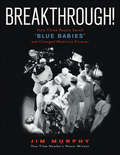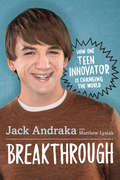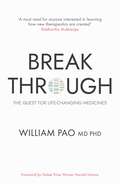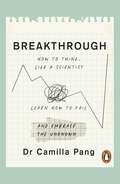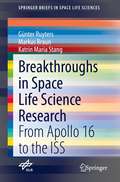- Table View
- List View
Breaking Boundaries
by Johan Rockstrom Owen GaffneyAn accessible summary of the planetary emergency and how to turn things around, from authors whose work is the focus of a new Netflix documentary narrated by David Attenborough.On the brink of a critical moment in human history, this book presents a vision of &“planetary stewardship&” – a rethinking of our relationship with our planet – and plots a new course for our future. The authors, whose work is the subject of a new documentary due to air on Netflix summer 2021, reveal the full scale of the planetary emergency we face – but also how we can stabilize Earth&’s life support system. The necessary change is within our power, if we act now. In 2009, scientists identified nine planetary boundaries that keep Earth stable, ranging from biodiversity to ozone. Beyond these boundaries lurk tipping points. In order to stop short of these tipping points, the 2020s must see the fastest economic transition in history. This book demonstrates how societies are reaching positive tipping points that make this transition possible: groups such as the schoolchildren led by Greta Thunberg demand political action; countries are committing to eliminating greenhouse gas emissions; and one tipping point has even already passed – the price of clean energy has dropped below that of fossil fuels. The story is accompanied by unique images of Earth produced by Globaïa, the world&’s leading visualizers of human impact.
Breaking Boundaries: Pioneering Sustainable Solutions Through Materials and Technology
by Mir Waqas AlamThis book explores sustainable innovation by delving into advanced materials science and technology. Each chapter reveals the transformative potential of sustainable solutions, from groundbreaking advancements in nanomaterials to eco-friendly manufacturing practices. This book offers a captivating glimpse into the potential future of sustainability, appealing to experienced researchers, budding innovators, and those with a general interest in the topic. Also, this book provides valuable insights into recent developments in materials science and technology, catering to academics, engineers, and policymakers. It aims to promote collaboration across many disciplines and encourage innovation to speed up the development of sustainable solutions that will have a long-lasting positive effect on future generations.
Breaking New Ground: A Personal History
by Lester R. BrownAn inspirational memoir tracing Lester Brown's life from a small-farm childhood to leadership as a global environmental activist. Lester R. Brown, whom the Washington Post praised as "one of the world's most influential thinkers," built his understanding of global environmental issues from the ground up. Brown spent his childhood working on the family's small farm. His entrepreneurial skills surfaced early. Even while excelling in school, he launched with his younger brother a tomato-growing operation that by 1958 was producing 1.5 million pounds of tomatoes. Later, at the U.S. Department of Agriculture, Brown emphasized the need for systemic thinking. In 1963 he did the first global food supply and demand projections to the end of the century. While on a brief assignment in India in 1965, he pieced together the clues that led him to sound the alarm on an impending famine there. His urgent warning to the U.S. and Indian governments set in motion the largest food rescue effort in history, helping to save millions of lives. This experience led India to adopt new agricultural practices, which he helped to shape. Brown went on to advise governments internationally and to found the Worldwatch and Earth Policy institutes, two major nonprofit environmental research organizations. Both brilliant and articulate, through his many books he has brought to the fore the interconnections among such issues as overpopulation, climate change, and water shortages and their effect on food security. His 1995 book, Who Will Feed China?, led to a broad restructuring of China's agricultural policy. Never one to focus only on the problem, Brown always proposes pragmatic, employable solutions to stave off the unfolding ecological crises that endanger our future.
Breaking Through!: Helping Girls Succeed in Science, Technology, Engineering, and Math
by Harriet Mosatche Elizabeth Lawner Susan Matloff-NievesEven with increased pressure to involve more girls in STEM areas in education, parents are often left wondering what they can do to encourage their daughter's love of science, math, and technology from fading. In Breaking Through! Helping Girls Succeed in Science, Technology, Engineering, and Math, topics ranging from how role models can make a difference to finding non-stereotypical toys and taking trips that inspire STEM discovery and engagement are illustrated with research evidence and real-life examples from girls and women. Regardless of a daughter's age (from birth to young adulthood), parents will find tips they can immediately use to help combat the gender imbalance in STEM areas. Whether they need to advocate for gender-neutral, STEM-enriched classrooms or want to encourage creative problem-solving and persistence in their daughters, readers will find ideas to take action to help the girls in their lives break through the barriers and achieve success in STEM.
Breaking Through!: Helping Girls Succeed in Science, Technology, Engineering, and Math
by Harriet S. Mosatche Elizabeth Lawner Susan Matloff-NievesEven with increased pressure to involve more girls in STEM areas in education, parents are often left wondering what they can do to keep their daughter's love of science, math, and technology from fading. In Breaking Through! Helping Girls Succeed in Science, Technology, Engineering, and Math, topics ranging from how role models can make a difference to finding nonstereotypical toys and taking trips that inspire STEM discovery and engagement are illustrated with research evidence and real-life examples from girls and women. Regardless of a daughter's age (from birth to young adulthood), parents will find tips they can immediately use to help combat the gender imbalance in STEM areas. Whether they need to advocate for gender-neutral, STEM-enriched classrooms or want to encourage creative problem solving and persistence in their daughters, readers will find ideas to take action to help the girls in their lives break through the barriers and achieve success in STEM.2017 NAGC Book of the Year Award Winner
Breaking Through: Essays, Journals, and Travelogues of Edward F. Ricketts
by Edward F. RickettsThis unprecedented collection, featuring previously unpublished pieces as well as others available for the first time in their original form, reflects the wide scope of Ricketts's scientific, philosophical, and literary interests during the years he lived and worked on Cannery Row in Monterey, California.
Breaking Through: My Life in Science
by Katalin KarikóA powerful memoir from Katalin Karikó, winner of the 2023 Nobel Prize in Physiology or Medicine, whose decades-long research led to the COVID-19 vaccines &“Katalin Karikó&’s story is an inspiration.&”—Bill Gates&“Riveting . . . a true story of a brilliant biochemist who never gave up or gave in.&”—Bonnie Garmus, author of Lessons in ChemistryA KIRKUS REVIEWS BEST BOOK OF THE YEARKatalin Karikó has had an unlikely journey. The daughter of a butcher in postwar communist Hungary, Karikó grew up in an adobe home that lacked running water, and her family grew their own vegetables. She saw the wonders of nature all around her and was determined to become a scientist. That determination eventually brought her to the United States, where she arrived as a postdoctoral fellow in 1985 with $1,200 sewn into her toddler&’s teddy bear and a dream to remake medicine. Karikó worked in obscurity, battled cockroaches in a windowless lab, and faced outright derision and even deportation threats from her bosses and colleagues. She balked as prestigious research institutions increasingly conflated science and money. Despite setbacks, she never wavered in her belief that an ephemeral and underappreciated molecule called messenger RNA could change the world. Karikó believed that someday mRNA would transform ordinary cells into tiny factories capable of producing their own medicines on demand. She sacrificed nearly everything for this dream, but the obstacles she faced only motivated her, and eventually she succeeded.Karikó&’s three-decade-long investigation into mRNA would lead to a staggering achievement: vaccines that protected millions of people from the most dire consequences of COVID-19. These vaccines are just the beginning of mRNA&’s potential. Today, the medical community eagerly awaits more mRNA vaccines—for the flu, HIV, and other emerging infectious diseases.Breaking Through isn&’t just the story of an extraordinary woman. It&’s an indictment of closed-minded thinking and a testament to one woman&’s commitment to laboring intensely in obscurity—knowing she might never be recognized in a culture that is driven by prestige, power, and privilege—because she believed her work would save lives.
Breaking of Supersymmetry and Ultraviolet Divergences in Extended Supergravity: Proceedings of the INFN-Laboratori Nazionali di Frascati School 2013 (Springer Proceedings in Physics #153)
by Stefano BellucciThis is the seventh volume in a series on the general topics of supersymmetry, supergravity, black objects (including black holes) and the attractor mechanism. The present volume is based on lectures held in March 2013 at the INFN-Laboratori Nazionali di Frascati during the Breaking of supersymmetry and Ultraviolet Divergences in extended Supergravity Workshop (BUDS 2013), organized by Stefano Bellucci, with the participation of prestigious speakers including P. Aschieri, E. Bergshoeff, M. Cederwall, T. Dennen, P. Di Vecchia, S. Ferrara, R. Kallosh, A. Karlsson, M. Koehn, B. Ovrut, A. Van Proeyen, G. Ruppeiner. Special attention is devoted to discussing topics related to the cancellation of ultraviolet divergences in extended supergravity and Born-Infeld-like actions. All talks were followed by extensive discussions and subsequent reworking of the various contributions a feature which is reflected in the unique "flavor" of this volume.
Breaking the Age Code: How Your Beliefs About Aging Determine How Long and Well You Live
by Becca Levy PhDYale professor and leading expert on the psychology of successful aging, Dr. Becca Levy, draws on her ground-breaking research to show how age beliefs can be improved so they benefit all aspects of the aging process, including the way genes operate and the extension of life expectancy by 7.5 years.The often-surprising results of Levy’s science offer stunning revelations about the mind-body connection. She demonstrates that many health problems formerly considered to be entirely due to the aging process, such as memory loss, hearing decline, and cardiovascular events, are instead influenced by the negative age beliefs that dominate in the US and other ageist countries. It’s time for all of us to rethink aging and Breaking the Age Code shows us how to do just that.Based on her innovative research, stories that range from pop culture to the corporate boardroom, and her own life, Levy shows how age beliefs shape all aspects of our lives. She also presents a variety of fascinating people who have benefited from positive age beliefs as well as an entire town that has flourished with these beliefs.Breaking the Age Code is a landmark work, presenting not only easy-to-follow techniques for improving age beliefs so they can contribute to successful aging, but also a blueprint to reduce structural ageism for lasting change and an age-just society.
Breaking the Mold: Changing the Face of Climate Science (Books for a Better Earth)
by Dana Alison LevySixteen scientists. Protecting our planet. Making science more equitable.Scientists who collect microbes from surfers' skin, who use radar sensors to gather data miles away, who combat inequality by pushing for cleaner air policies. Each with their own story, all working to make life better for future generations.Celebrated author Dana Alison Levy profiles 16 people, all studying different elements of the earth&’s landscape, animals, and climate, who defy stereotypes of who can be a scientist. From analytical chemists to volcanologists, from global experts to recent graduates, these scientists share what they were like as young people, how they got where they are now, and what they—and the rest of us—can do to help the planet.Based on extensive interviews and featuring infographics and personal photos, Breaking the Mold offers a snapshot of the people and organizations fighting to make science more equitable. Back matter includes advice for readers interested in science careers, DIY projects, paths to community involvement, and more.Books for a Better Earth are designed to inspire children to become active, knowledgeable participants in caring for the planet they live on.
Breaking the Ring
by John BarronThe bizarre case of the espionage operation of the John Walker family and the U.S. government's hunt for the spy and his accomplices.
Breaking the Silos for Planetary Health: A Roadmap for a Resilient Post-Pandemic World
by Nicole de PaulaThis book translates the latest theoretical perspectives on the emerging field of Planetary Health Studies into the practical reality of global political decision makers. It builds on the scientific data on the impacts of environmental change on human health to propose practical methods for operationalizing planetary health. The book maps opportunities for decision makers to break institutional silos and engage with bottom-up approaches that can transform planetary health from a global idea into a local reality. The analysis frames human health in the Anthropocene, an era in which humans have become the most powerful force affecting global ecosystems, and reveals new existential risks for humankind.Departing from ongoing multilateral efforts to promote sustainability, the author’s analysis places the agenda of planetary health on the desk of political decision makers, still underrepresented at planetary health gatherings. Given the pressing need to implement sustainable development policies, the book presents planetary health as an overarching framework for global policy targets, notably the UN Sustainable Development Goals, the Paris Agreement on Climate Change, and the post-2020 biodiversity framework under the UN Convention on Biological Diversity. The book is timely in offering a concrete road map for practitioners and researchers interested in transforming the concept of planetary health into reality. With a collection of success stories, the analysis dwells on tools for community engagement, opportunities for health professionals training, gender empowerment, digital health, and innovative ways to enhance human well-being on a changing planet.
Breaking the Spell
by Daniel C. DennettFew forces in the world are as potent as religion: it comforts people in their suffering and inspires them to both magnificent and terrible deeds. In this provocative and timely book, Daniel C. Dennett seeks to uncover the origins of religion and discusses how and why different faiths have shaped so many lives, whether religion is an addiction or a genuine human need, and even whether it is good for our health. Arguing passionately for the need to understand this multifaceted phenomenon, Breaking the Spell offers a truly original - and comprehensive - explanation for faith.
Breaking the Spell: Religion as a Natural Phenomenon
by Daniel C. DennettFor all the thousands of books that have been written about religion, few until this one have attempted to examine it scientifically: to ask why-and how-it has shaped so many lives so strongly. Is religion a product of blind evolutionary instinct or rational choice? Is it truly the best way to live a moral life? Ranging through biology, history, and psychology, Daniel C. Dennett charts religion's evolution from "wild" folk belief to "domesticated" dogma. Not an antireligious screed but an unblinking look beneath the veil of orthodoxy, Breaking the Spell will be read and debated by believers and skeptics alike.
Breaking the Time Barrier: The Race to Build the First Time Machine
by Jenny RandlesIT WAS ONLY A MATTER OF TIME.... Once widely considered an impossibility--the stuff of science fiction novels--time travel may finally be achieved in the twenty-first century. In Breaking the Time Barrier, bestselling author Jenny Randles reveals the nature of recent, breakthrough experiments that are turning this fantasy into reality. The race to build the first time machine is a fascinating saga that began about a century ago, when scientists such as Marconi and Edison and Einstein carried out research aimed at producing a working time machine. Today, physicists are conducting remarkable experiments that involve slowing the passage of information, freezing light, and breaking the speed of light--and thus the time barrier. In the 1960s we had the "space race." Today, there is a "time race" involving an underground community of working scientists who are increasingly convinced that a time machine of some sort is finally possible. Here, Randles explores the often riveting motives of the people involved in this quest (including a host of sincere, if sometimes misguided amateurs), the consequences for society should time travel become a part of everyday life, and what evidence might indicate that it has already become reality. For, if time travel is going to happen--and some Russian scientists already claim to have achieved it in a lab--then its effects may already be apparent.
Breakpoint: Reckoning with America's Environmental Crises
by Jeremy B. Jackson Steve ChappleAn insightful look at the American environmental crisis and emerging solutions from the heartland to the coasts in the era of global climate change†‹ Eminent ecologist Jeremy B. C. Jackson and award†‘winning journalist Steve Chapple traveled the length of the Mississippi River interviewing farmers, fishermen, scientists, and policymakers to better understand the mounting environmental problems ravaging the United States. Along their journey, which quickly expands to California, Florida, and New York, the pair uncovered surprising and profound connections between ecological systems and environmental crises across the country. Artfully weaving together independent research and engaging storytelling, Jackson and Chapple examine the looming threats from recent hurricanes and fires, industrial agriculture, river mismanagement, extreme weather events, drought, and rising sea levels that are pushing the country toward the breaking point of ecological and economic collapse. Yet, despite these challenges, the authors provide optimistic and practical solutions for addressing these multidimensional issues to achieve greater environmental stability, human well†‘being, and future economic prosperity. With a passionate call to action, they look hopefully toward emerging and achievable solutions to preserve the country’s future.
Breakpoint: Why The Web Will Implode, Search Will Be Obsolete, and Everything Else You Need To Know About Technology Is In Your Brain
by Jeff StibelWhat can the human brain and its relationship to the internet tell us about our society, our technologies, and our businesses? A lot, as it turns out. The internet today is a virtual replica of the brain, and the networks that leverage it grow and collapse in ways that are easily predictable if you understand the brain and other biological networks. We're living in the midst of a networking revolution. All of the major technology innovations of the 21st century - social networking, cloud computing, search engines, and crowdsourcing, to name a few - leverage the internet and are thus bound by the rules of networks. We've seen the exponential growth of these technologies, and they've led to a more efficient and tightly connected world. But what many people don't realize is that all networks eventually reach a breakpoint and collapse. This happens in the brain, it happens in nature, it happened to MySpace, and it will happen to Facebook and Google. It is critical to understand where the breakpoint is in the networks you use in order to achieve optimum success. Navigating the world of new technologies today can be like walking through a minefield unless you know the path. Imagine what you could do with a roadmap for where things are headed? In this fascinating look at the future of business and technology, neuroscientist and entrepreneur Jeff Stibel shows how the brain can act as a guide to understanding the future of the internet and the constellation of businesses and technologies that run on it. He'll show how leaders like Marissa Mayer are using artificial intelligence to literally remake Yahoo! and how startups like oDesk and Kickstarter are using crowdsourcing, the next wave of revolutionary technology, to create something much larger and "smarter" than the sum of their parts. Stibel offers a fresh perspective about the future of business and technology in a candid and engaging manner.
Breakthrough!: 100 Astronomical Images That Changed the World
by Robert Gendler R. Jay GabanyThis unique volume by two renowned astrophotographers unveils the science and history behind 100 of the most significant astronomical images of all time. The authors have carefully selected their list of images from across time and technology to bring to the reader the most relevant photographic images spanning all eras of modern astronomical history. Based on scientific evidence today we have a basic notion of how Earth and the universe came to be. The road to this knowledge was paved with 175 years of astronomical images acquired by the coupling of two revolutionary technologies - the camera and telescope. With ingenuity and determination humankind would quickly embrace these technologies to tell the story of the cosmos and unravel its mysteries. This book presents in pictures and words a photographic chronology of our aspiration to understand the universe. From the first fledgling attempts to photograph the Moon, planets, and stars to the marvels of orbiting observatories that record the cosmos at energies beyond the range of human vision, astronomers have always relied on images to "break through" to the next level of understanding. A subset of these breakthrough images has profound significance in documenting some of the greatest milestones in modern astronomy.
Breakthrough!: How Three People Saved "Blue Babies" and Changed Medicine Forever
by Jim MurphyIn 1944 a groundbreaking operation repaired the congenital heart defect known as blue baby syndrome. The operation's success brought the surgeon Alfred Blalock international fame and paved the way for open-heart surgery. But the technique had been painstakingly developed by Vivien Thomas, Blalock's African American lab assistant, who stood behind Blalock in the operating room to give him step-by-step instructions. The stories of this medical and social breakthrough and the lives of Thomas, Blalock, and their colleague Dr. Helen Taussig are intertwined in this compelling nonfiction narrative.
Breakthrough: How One Teen Innovator Is Changing the World
by Matthew Lysiak Jack AndrakaFor the first time, teen innovator and scientist Jack Andraka tells the story behind his revolutionary discovery. When a dear family friend passed away from pancreatic cancer, Jack was inspired to create a better method of early detection. At the age of fifteen, he garnered international attention for his breakthrough: a four-cent strip of paper capable of detecting pancreatic, ovarian, and lung cancers four hundred times more effectively than the previous standard.Jack's story is not just a story of dizzying international success; it is a story of overcoming depression and homophobic bullying and finding the resilience to persevere and come out. His account inspires young people, who he argues are the most innovative, to fight for the right to be taken seriously and to pursue our own dreams. Do-it-yourself science experiments are included in each chapter, making Breakthrough perfect for STEM curriculum. But above all, Jack's memoir empowers his generation with the knowledge that we can each change the world if we only have the courage to try.
Breakthrough: Katalin Karikó and the mRNA Vaccine
by Stephanie Sammartino McPhersonA thorough and accessible biography of Dr. Katalin Karikó, winner of the 2023 Nobel Prize in Physiology or Medicine, whose hard work pioneering mRNA research led to the COVID-19 vaccines. Her monumental contribution to global health care has rightfully placed Karikó as one of the most important scientists in history. She has won awards, given speeches, and appeared in magazines and television programs. But she wasn’t always famous—in fact, it took decades for anyone to recognize the importance of her research into RNA and the potential of mRNA to help cells fight off disease. Beginning with her birth in a small village in rural Hungary, Breakthrough tells the story of how a young girl interested in the wildlife around her became an internationally celebrated hero. Exuberant, devoted to her family, and hard-working, Karikó persevered in the face of challenges and obstacles that would have discouraged many of her peers. Her achievements remind us that if we believe in ourselves, no matter the setbacks we encounter, we can succeed.
Breakthrough: The Quest for Life-Changing Medicines
by Dr William PaoMeet the doctors, scientists, patients and campaigners tackling the world&’s worst diseases We often hear about the dark side of the pharmaceutical industry – from extortionate pricing to the opioid epidemic. But there&’s another story to be told. Through the story of eight revolutionary treatments, Dr William Pao cuts to the innovative heart of medical science and celebrates the tireless work of those fighting for better care. Behind each of these medicines – whether a potentially life-saving new treatment for cancer, or something as commonplace as paracetamol – there stands a cast of characters and a wealth of stories. The trajectory from the laboratory to the local chemist is rarely a straight line. Eureka moments are few are far between. Drug hunting demands leaps of imagination and lateral thinking, the accumulation of the knowledge and expertise of many, and – nearly always – a hefty dollop of luck. Breakthrough documents these journeys and grants a privileged look at the stories behind the medicines that improve – and very often save – our lives.
Breakthrough: What can we learn about the world and ourselves if we think like scientists?
by Camilla PangFROM THE AWARD-WINNING AUTHOR OF EXPLAINING HUMANS'A wondrous hymn to the scientific method, and some of its most profound discoveries, and what it can teach us all about how to live better and richer lives' Prof. Lewis Dartnell, author of BEING HUMAN: How our Biology shaped World HistoryA scientist’s journey from observation to discovery is anything but straightforward.It is littered with failure, unexpected diversions and joyous realizations. Science helps us to understand ourselves – but what we know about the world around us, what has already been explored and discovered, is only half of science’s story.Dr Camilla Pang will look at some of the biggest mysteries facing science today and how some of the best, most cutting-edge scientists can illuminate our own approaches to observation, hypothesis, exploration, troubleshooting and discovery in our own lives.
Breakthroughs in Space Life Science Research: From Apollo 16 to the ISS (SpringerBriefs in Space Life Sciences)
by Markus Braun Günter Ruyters Katrin Maria StangThis last volume of the SpringerBriefs in Space Life Sciences series is setup in 5 main parts. The 1st part shortly summarizes the history of life science research in space from the late 40s until today with focus on Europe and Germany, followed by a part on describing flight opportunities including the Space Shuttle/Spacelab system and the International Space Station ISS; in the 3rd part it focuses on extraordinary success stories of this constantly challenging research program and highlights some important key findings in space life science research. The book introduces in the 4th part innovative developments in non-invasive biomedical diagnostics and training methods for astronauts that emerge from this program and are of benefit for people on Earth especially in the aging society. Last but not least in its 5th part it closes with an outlook on the future of space life sciences in the upcoming era of space exploration. The book is intended for students and research scientists in the life sciences and biomedicine as well as for interested lay persons, who wish to get an overview of space life science research: its´ early days, current status and future directions.
Breakthroughs: Realizing Our Potentials Through Dynamic Tricky Mixes
by Keith NelsonBreakthroughs show readers the world of Tricky Mixes as key pathways to breakthrough advances--estimates of human potential may never be the same again. Dynamic Systems theories and research provide the backbone concepts for Breakthroughs. Yet, readers discover that new Dynamic Mixes reveal untapped human potential in everyday situations not just in rigorous scientific studies. Individuals, small groups, and large organizations often get "stuck" in their progress by failing to respect and explore the complex interacting factors impacting their situations. Breakthroughs present countless examples which reveal that variants of the same dynamic processes underlie being stuck, versus progressing at modest rates, or advancing at turbo speeds. These examples and events are drawn from research with Keith E. Nelson’s colleagues plus many independent labs around the world, as well as from first-person episodes of many kinds and from many sources. New cross-domain explorations and new insights propel readers into much higher levels of creativity, innovation, rapid learning, social problem solving, curiosity, and life balance. The Dynamic Tricky Mix perspective in most contexts helps shake up and improve paths toward solutions. In times of crisis, as in the Covid-19 pandemic, it becomes especially important to bring this kind of thinking to bear.
